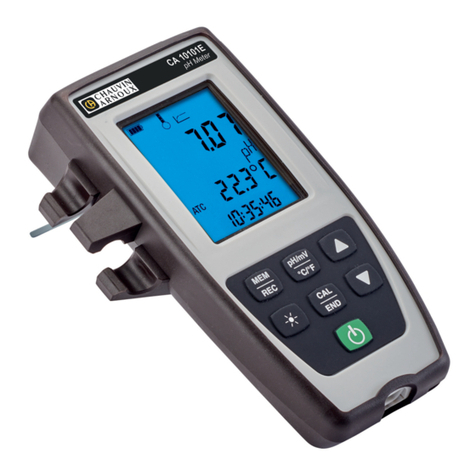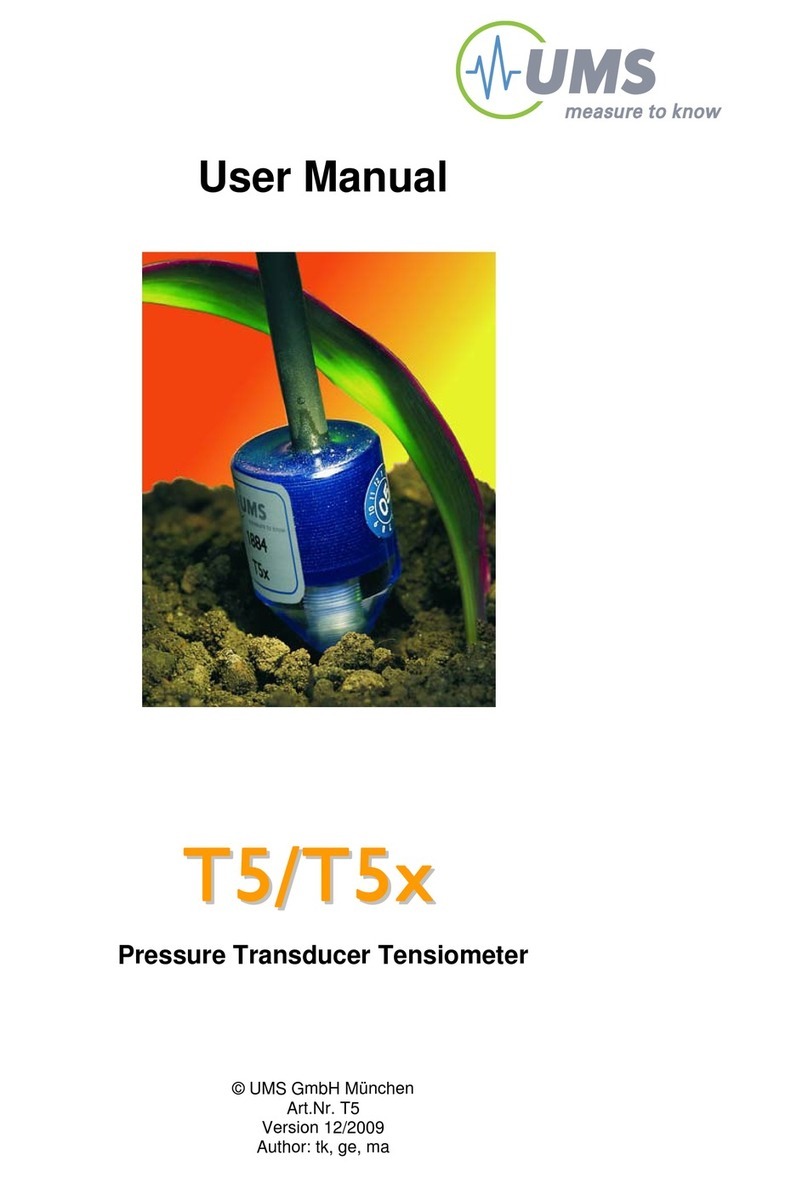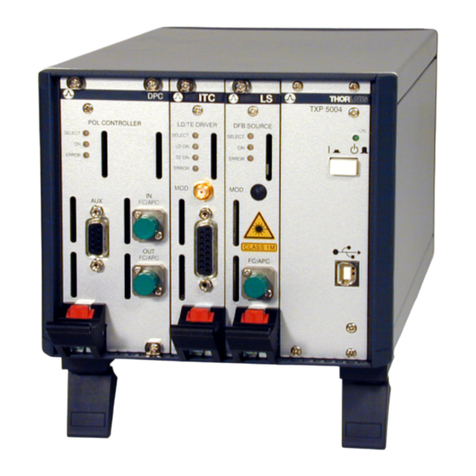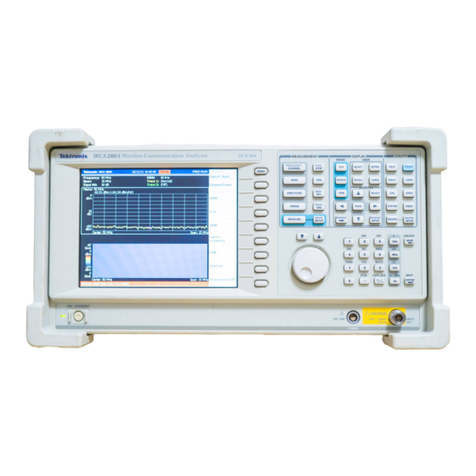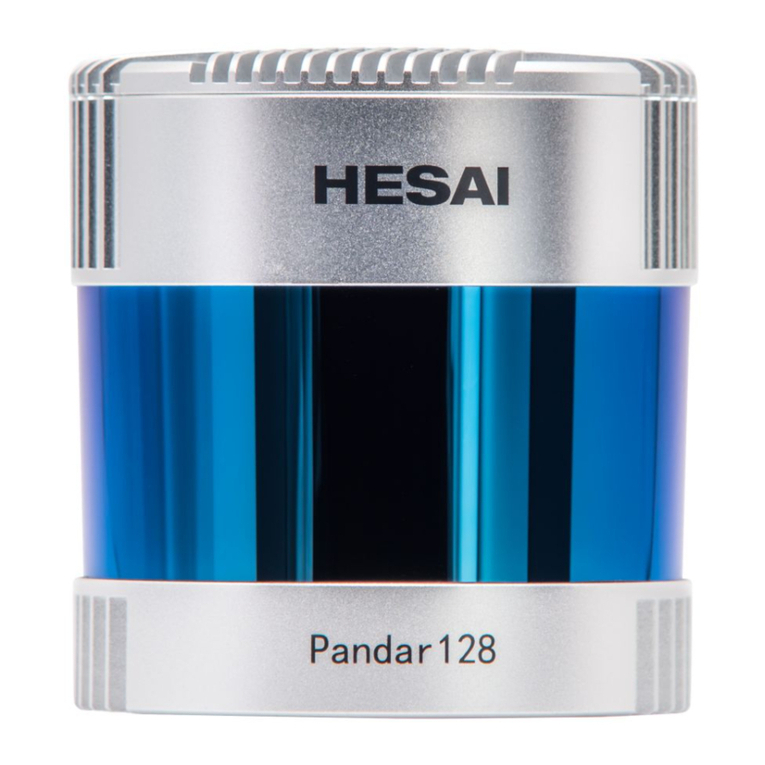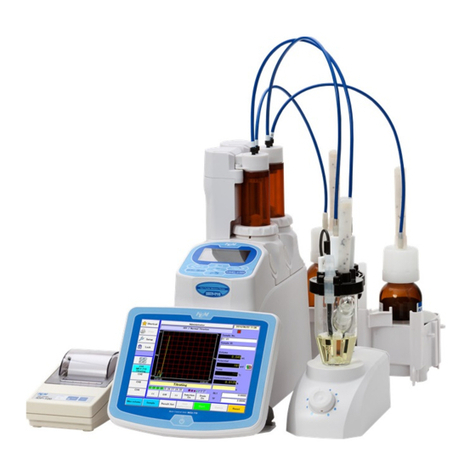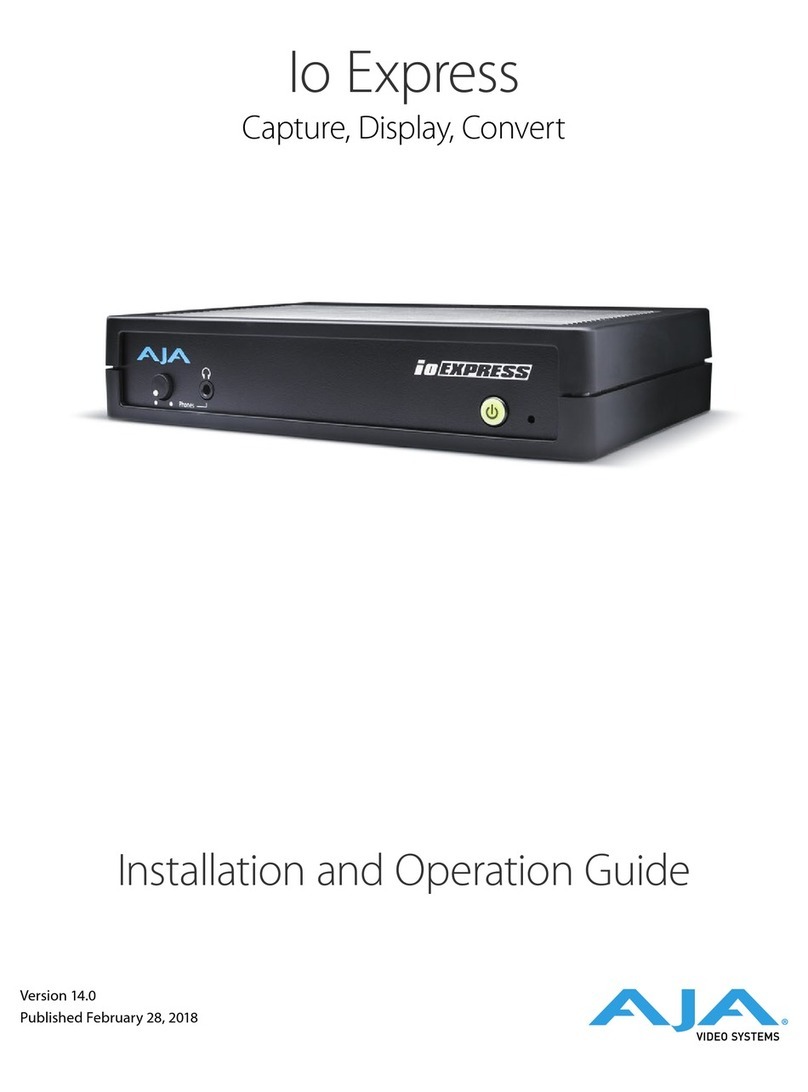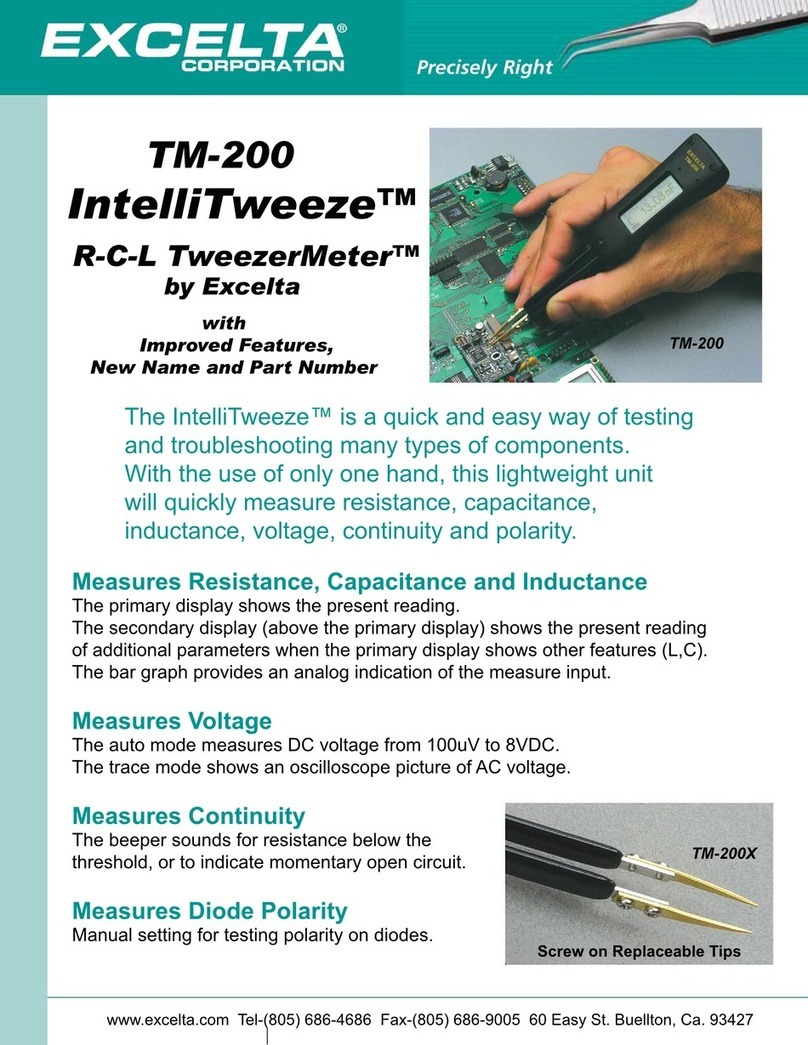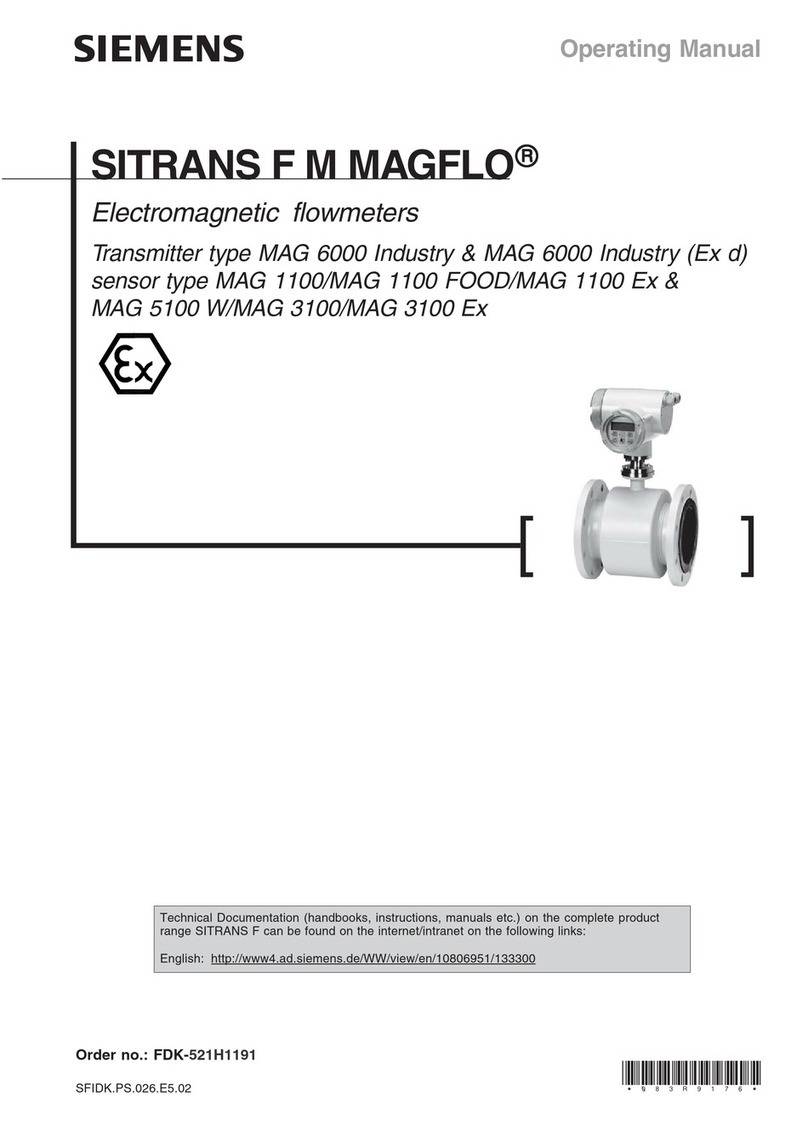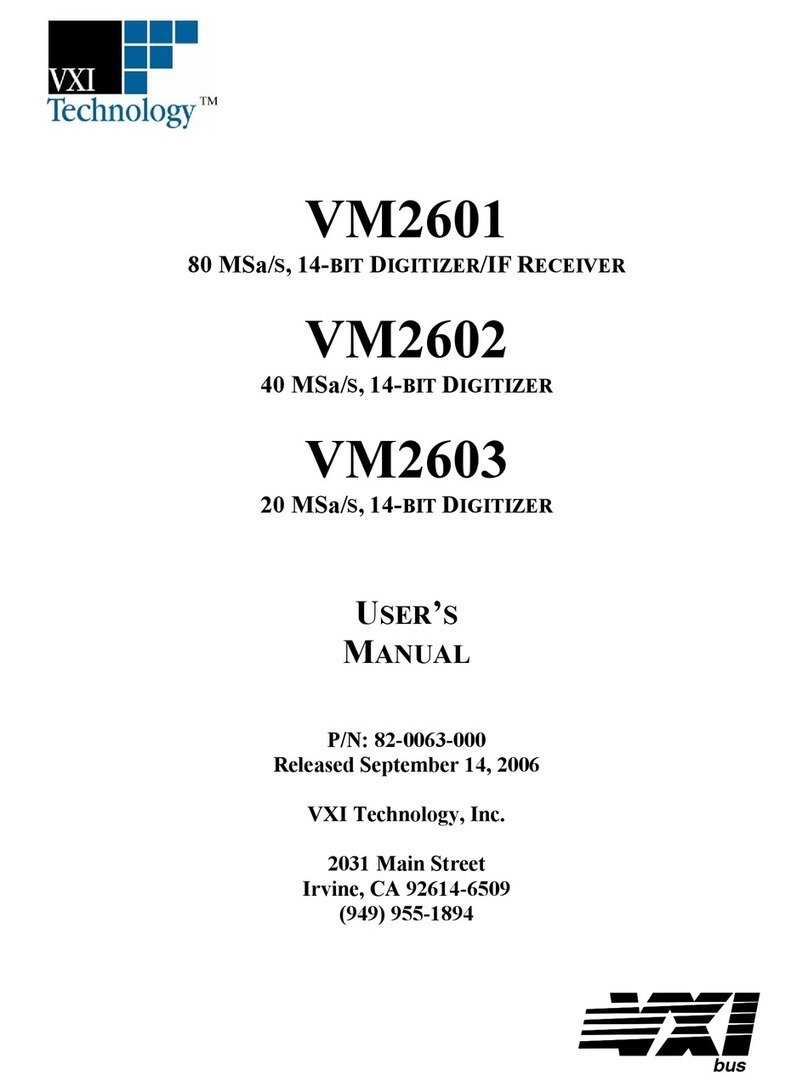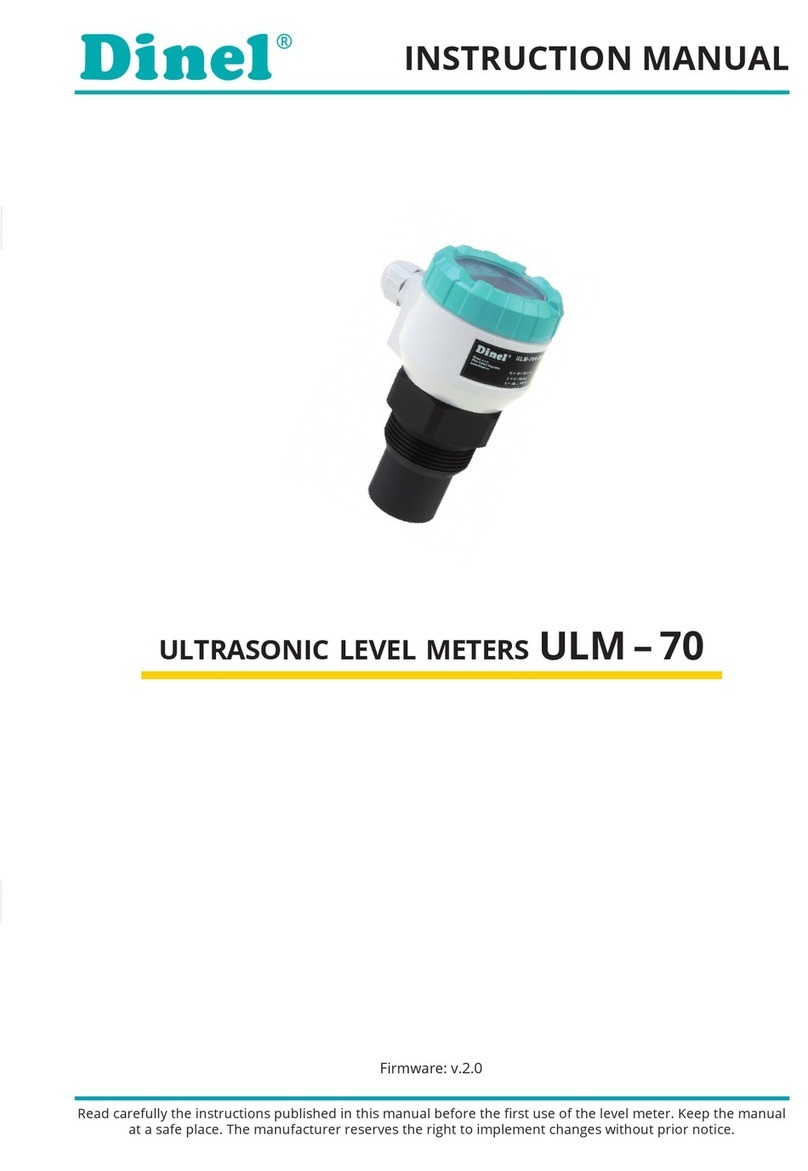Citadel CTD-N Series User manual

Information included herein is controlled by the Export Administration Regulations (EAR) and may require an export license, license
exception or other approval from the appropriate U.S. Government agency before being exported from the United States or provided to
any foreign person. Diversion contrary to U.S. law is prohibited.
CTD-N
CTD-NV, CT-NV, CTD-NH, and CT-NH
Technical Manual
P/N 95F-6000-00 (February 2017)
© 2017 Teledyne RD Instruments, Inc. All rights reserved.

EAR-Controlled Technology Subject to Restrictions Contained on the Cover Page.

EAR-Controlled Technology Subject to Restrictions Contained on the Cover Page.
Table of Contents
Introduction........................................................................................................................................................... 1
Maximum Operating Depth........................................................................................................................................................ 1
System Configuration Requirements.......................................................................................................................................... 2
Pull-Down Menus ....................................................................................................................................................................... 2
Customer Service........................................................................................................................................................................ 3
Main External Components ........................................................................................................................................................ 4
CTD-N Options............................................................................................................................................................................ 7
Specifications.............................................................................................................................................................................. 8
Outline Installation Drawings ................................................................................................................................................... 10
Unpacking the CTD-N and Connecting It to Your Computer ................................................................................. 12
Unpacking the CTD-N ............................................................................................................................................................... 12
Battery Pack ....................................................................................................................................................................... 12
Standard Items ................................................................................................................................................................... 12
Optional Items.................................................................................................................................................................... 13
Installing CTDPro and Selecting the CTD-N............................................................................................................................... 13
Installing CTDPro ................................................................................................................................................................ 13
Selecting the CTD-N ........................................................................................................................................................... 14
Communication Interfaces ....................................................................................................................................................... 14
RS-232 Interface................................................................................................................................................................. 14
RS-485 Interface Option..................................................................................................................................................... 15
CMOS Interface Option ...................................................................................................................................................... 15
Connecting the CTD-N to Your Computer ................................................................................................................................ 15
Connecting to the RS-232 Interface ................................................................................................................................... 15
Using the CTD-N End Cap Switch........................................................................................................................................ 16
Connecting a PC to the CTD-N with an End cap Switch...................................................................................................... 16
Connecting to the RS-485 Interface ................................................................................................................................... 17
Changing the Serial Port ........................................................................................................................................................... 18
Changing the Baud Rate ........................................................................................................................................................... 19
Changing the Baud Rate of the Serial Port ......................................................................................................................... 19
Automatically Changing the Baud Rate of the Serial Port to the Baud Rate of the CTD-N................................................. 20
Changing the Baud Rate of the CTD-N and the Serial Port................................................................................................. 20
Connecting and Setting up Communications with a GPS ......................................................................................................... 21
Checking, Configuring, & Deploying the CTD-N .................................................................................................... 23
CTD-N Configuration Settings ................................................................................................................................................... 23
Running Modes .................................................................................................................................................................. 24
Averaged Data.................................................................................................................................................................... 25
Sampling Rate .................................................................................................................................................................... 25
Time and Date .................................................................................................................................................................... 26
Serial Number .................................................................................................................................................................... 26
Communications Options ......................................................................................................................................................... 27
Predeployment Checks............................................................................................................................................................. 28
Verifying Battery Pack Capacity and Memory Requirements ............................................................................................ 28
Running the Diagnostic Tests ............................................................................................................................................. 32
Configuring and Deploying the CTD-N...................................................................................................................................... 36
Configuring and Deploying the CTD-N in Continuous Mode .............................................................................................. 36
Configuring and Deploying the CTD-N in Interval Mode .................................................................................................... 38
Configuring and Deploying the CTD-N in Delayed Start Continuous Mode........................................................................ 41
Configuring and Deploying the CTD-N in Delayed Start Interval Mode.............................................................................. 44
Using Battery End Cap Enabled Interval Mode .................................................................................................................. 47
Battery End Cap Enabled – Delayed Start Interval ............................................................................................................. 47
CTD-N Autolog Feature............................................................................................................................................................. 48
Selecting and Activating the Autolog Feature .................................................................................................................... 49
Autolog Typical Applications and Procedures .................................................................................................................... 50
Retrieving and Displaying Data from the CTD-N................................................................................................... 53

EAR-Controlled Technology Subject to Restrictions Contained on the Cover Page.
Downloading and Saving Data from the CTD-N........................................................................................................................ 53
Exporting and Viewing Saved Data........................................................................................................................................... 55
Exporting Saved Data ......................................................................................................................................................... 56
Viewing Data That Have Been Exported to a Text File ....................................................................................................... 57
Displaying, Printing, and Saving Graphs ................................................................................................................................... 58
Displaying Data versus Pressure or Time ........................................................................................................................... 59
Viewing Data on a Graph ................................................................................................................................................... 59
Zooming in and Out of a Graph.......................................................................................................................................... 60
Setting up a Graph ............................................................................................................................................................. 60
Saving a Graph ................................................................................................................................................................... 62
Previewing and Printing a Graph........................................................................................................................................ 63
Viewing File Information .................................................................................................................................................... 63
Erasing All the Data Files .......................................................................................................................................................... 64
Acquiring, Displaying, and Saving Data in Real Time ............................................................................................ 66
Starting Data Acquisition .......................................................................................................................................................... 66
Stopping Data Acquisition ........................................................................................................................................................ 69
Viewing Saved Data .................................................................................................................................................................. 69
CTD-N Acquisition Window Displays ........................................................................................................................................ 70
CTD-N Maintenance............................................................................................................................................. 71
Recommended Maintenance ................................................................................................................................................... 71
Cleaning and Inspecting the CTD-N .......................................................................................................................................... 72
Replacing the Battery Pack....................................................................................................................................................... 74
Oil Fill Procedure and Capillary Tube Installation ..................................................................................................................... 78
Installing a CTD-N End Cap Switch Kit....................................................................................................................................... 81
Firmware Updates .................................................................................................................................................................... 82
APPENDIX A: Measured and Calculated Parameters ........................................................................................... 85
Parameters Measured by the CTD-N........................................................................................................................................ 85
Parameters Calculated by the CTD-N ....................................................................................................................................... 85
Parameters Calculated by CTDPro............................................................................................................................................ 86
APPENDIX B: Bulkhead Connector Wiring ........................................................................................................... 87
APPENDIX C: Optional Sensors............................................................................................................................ 91
Seapoint Turbidity Sensor ........................................................................................................................................................ 95
Selecting the Range for the Seapoint Turbidity Sensor ...................................................................................................... 95
Calibrating the Seapoint Turbidity Sensor.......................................................................................................................... 97
Seapoint Fluorometer Sensor................................................................................................................................................... 98
Selecting the Range for the Seapoint Fluorometer Sensor ................................................................................................ 98
Calibrating the Seapoint Fluorometer Sensor .................................................................................................................... 99
Calibrating the External Sensors............................................................................................................................................. 100
APPENDIX D: CTD-N Commands........................................................................................................................ 103
CTD-N Operating Modes......................................................................................................................................................... 103
Command Properties.............................................................................................................................................................. 103
Entering Commands ............................................................................................................................................................... 104
START .............................................................................................................................................................. 108
***R ................................................................................................................................................................ 109
***O ............................................................................................................................................................... 110
***C ................................................................................................................................................................ 111
***I ................................................................................................................................................................. 112
***D................................................................................................................................................................ 113
***E ................................................................................................................................................................ 114
CDATE ............................................................................................................................................................. 115
SRATE .............................................................................................................................................................. 116
DTIME ............................................................................................................................................................. 117
DDATE ............................................................................................................................................................. 118
ITIME............................................................................................................................................................... 119
OTIME ............................................................................................................................................................. 120

EAR-Controlled Technology Subject to Restrictions Contained on the Cover Page.
RCAL................................................................................................................................................................ 121
CCKO, RCKO, SCKO.......................................................................................................................................... 122
CSOT, RSOT, SSOT ........................................................................................................................................... 123
CCOP, RCOP, SCOP.......................................................................................................................................... 124
SB .................................................................................................................................................................... 125
MODE.............................................................................................................................................................. 126
CAOP, RAOP, SAOP, #N................................................................................................................................... 127
TIME................................................................................................................................................................ 129
DATE ............................................................................................................................................................... 130
DIAG................................................................................................................................................................ 131
ZMEM ............................................................................................................................................................. 132
FDMP .............................................................................................................................................................. 133
AVGI ................................................................................................................................................................ 134
CHKF................................................................................................................................................................ 135
DDMP.............................................................................................................................................................. 136
BDMP .............................................................................................................................................................. 137
DLEN ............................................................................................................................................................... 138
LOG ................................................................................................................................................................. 139
S/N .................................................................................................................................................................. 140
ROP ................................................................................................................................................................. 141
VER.................................................................................................................................................................. 142
WHO ............................................................................................................................................................... 143
ADR ................................................................................................................................................................. 144
RDM ................................................................................................................................................................ 145
DIR .................................................................................................................................................................. 145
C...................................................................................................................................................................... 147
CH ................................................................................................................................................................... 147
? ...................................................................................................................................................................... 149
S ...................................................................................................................................................................... 150
SC .................................................................................................................................................................... 151
SFRM .............................................................................................................................................................. 152
GAIN0.............................................................................................................................................................. 154
GAIN1.............................................................................................................................................................. 155
APPENDIX E: Warranty, Liability, and RMA Return Procedure ........................................................................... 156
Teledyne RD Instruments Limited Warranty .......................................................................................................................... 156
Liability ................................................................................................................................................................................... 156
Returning CTDs to TRDI for Service .................................................................................................................... 157
Domestic Shipments............................................................................................................................................................... 157
European Shipments .............................................................................................................................................................. 158
List of Figures
Figure 1. The Location of the CTD-NV Main External Components ............................................................. 4
Figure 2. The Location of the CTD-NH Main External Components............................................................. 5
Figure 3. The Location of the CT-NH Main External Components................................................................ 6
Figure 4. Outline Installation Drawing, CTD-NV & CT-NV, NXIC Vertical .................................................... 10
Figure 5. Outline Installation Drawing, CTD-NH & CT-NH, NXIC Horizontal ............................................... 11
Figure 6. The Properties Dialog Box.......................................................................................................... 14
Figure 7. CTD-N Setup—with RS-232 Interface ......................................................................................... 16
Figure 8. CTD-N Setup with B176-207 Battery Adapter Cable................................................................... 17
Figure 9. CTD-N Setup—with RS-485 Interface ......................................................................................... 18
Figure 10. The Communication Properties Dialog Box ................................................................................ 19
Figure 11. The Communication Rate Dialog Box ......................................................................................... 21
Figure 12. The Navigation Setup Dialog Box ............................................................................................... 21
Figure 13. The CTD-N Configuration Dialog Box.......................................................................................... 24

EAR-Controlled Technology Subject to Restrictions Contained on the Cover Page.
Figure 14. Run Time Diagram, Including Average Times, for One Interval Time Cycle ................................. 26
Figure 15. The Advanced Settings Dialog Box ............................................................................................. 27
Figure 16. The Battery Life Dialog Box—Entering the Battery Pack Capacity Sample Rate and Average
Times 29
Figure 17. The Battery Life Dialog Box—Selecting the Running Mode ........................................................ 30
Figure 18. The Battery Life Dialog Box—Deployment Summary.................................................................. 31
Figure 19. The Save As Dialog Box for Battery Pack Information Files ......................................................... 32
Figure 20. The Diagnostics Dialog Box ........................................................................................................ 33
Figure 21. Save As Dialog Box for Diagnostics Data Files............................................................................. 34
Figure 22. Results of Diagnostic Testing in the Diagnostics Dialog Box........................................................ 34
Figure 23. Flowchart for the CTD-N Autolog Feature .................................................................................. 49
Figure 24. Activating the Autolog feature in the Advanced Settings dialog box .......................................... 50
Figure 25. The Download Dialog Box .......................................................................................................... 54
Figure 26. The Save As Dialog Box for CTD Data Files.................................................................................. 54
Figure 27. The Export Dialog Box................................................................................................................ 56
Figure 28. The Open Dialog Box for CTD Data Files ..................................................................................... 57
Figure 29. Example CTD-N Data File Printout.............................................................................................. 58
Figure 30. The Graphics Display Opened to the Conductivity Graph........................................................... 60
Figure 31. The 2D Chart Control Properties Dialog Box............................................................................... 61
Figure 32. The Temperature Graph ............................................................................................................. 61
Figure 33. The Pressure Graph.................................................................................................................... 62
Figure 34. Save Graph Dialog Box ............................................................................................................... 62
Figure 35. The Save As Dialog Box for Image Files ...................................................................................... 63
Figure 36. The File Information Window..................................................................................................... 64
Figure 37. The Channel Configuration Dialog Box ....................................................................................... 67
Figure 38. The CTD-N Acquisition Window ................................................................................................. 68
Figure 39. The Acquisition Setup Dialog Box............................................................................................... 68
Figure 40. The Save As Dialog Box for ASCII Data Files................................................................................ 69
Figure 41. The CTD-N Acquisition Window with Real-Time Displays of Data............................................... 70
Figure 42. Cleaning the CTD-NH Sensor Head............................................................................................. 73
Figure 43. Contents of NXIC CTD End-cap Switch Kit:.................................................................................. 81
Figure 44. CTD-N Firmware Updates........................................................................................................... 84
Figure 45. 4-pin Bulkhead Connector Face View......................................................................................... 87
Figure 46. 6-Pin Bulkhead Connector Face View......................................................................................... 88
Figure 47. Test Cable Wiring ....................................................................................................................... 89
Figure 48. Battery Adapter Cable Wiring P/N B176-207.............................................................................. 90
Figure 49. Option 1 & Option 2 Connectors with 6-pin Connector on Lower End Cap ................................ 92
Figure 50. Option 1 and Option 2 Connectors Face View............................................................................ 93
Figure 51. CTD-N with Seapoint Turbidity Sensor Connected to the Option 1 Connector ........................... 96
Figure 52. The Sensor Setup Dialog Box—Selecting Seapoint Turbidity Sensor Range ................................ 97
Figure 53. The Sensor Setup Dialog Box—Selecting Seapoint Fluorometer Sensor Range........................... 99
Figure 54. The Calibrate Sensor Dialog Box—Selecting the Sensor ........................................................... 100
Figure 55. The Calibrate Sensor Dialog Box—Setting the Low................................................................... 101
Figure 56. The Calibrate Sensor Dialog Box—Setting Additional Standard Points Including the High Point
Standard 102
Figure 57. The Calibration Results Window .............................................................................................. 102
Figure 58. The Terminal Window .............................................................................................................. 104
List of Tables
Table 1: Optional Items Available from TRDI ........................................................................................... 13
Table 2. Recommended Maintenance ..................................................................................................... 71
Table 2: NXIC End cap Switch Kit Contents .............................................................................................. 81

EAR-Controlled Technology Subject to Restrictions Contained on the Cover Page.
Table 3: Bulkhead Connector Components.............................................................................................. 87
Table 4: Pigtail Color Codes/Functions .................................................................................................... 87
Table 5: CTD-N Bulkhead 4-pin Connector to Computer Connections ..................................................... 88
Table 6: CTD-N Bulkhead 4-pin Connector to Power Supply Connections................................................ 88
Table 7: CTD-N 6-pin Bulkhead Connector to Computer Connections ..................................................... 88
Table 8: CTD-N 6-pin Bulkhead Connector to Power Connections ........................................................... 88
Table 9: Test Cable Pin Out...................................................................................................................... 89
Table 10: Option Connectors Components................................................................................................ 92
Table 11: Option 1 Connector Connections............................................................................................... 93
Table 12: Option 2 Connector Connections............................................................................................... 93
Table 13: Seapoint Turbidity Sensor Range Selections............................................................................... 95
Table 14: Fluorometer Sensor Range Selections........................................................................................ 98
Table 15: CTD-N Commands.................................................................................................................... 105
Revision History
February 2017
•Updated overview graphics with the Capillary Tube Assembly.
•Added a recommended maintenance list to the maintenance chapter.
•Updated cleaning procedure.
•Updated Oil Fill Procedure and Capillary Tube Assembly.
•Updated TRDI website address to http://www.teledynemarine.com/rdi
April 2016
•Updated Internal Memory specification from “128MB; 256MB optional” to 256MB. All
NXIC CTDs use a 256MB internal recorder.
•Updated the CAOP, RAOP, SAOP commands.
•Added the #N command.
•Updated the SFRM and ADR commands.
•Combined CCKO, RCKO, SCKO commands into one page to better explain how the
commands interact.
•Combined CSOT, RSOT, SSOT commands into one page to better explain how the com-
mands interact.
•Combined CCOP, RCOP, SCOP commands into one page to better explain how the com-
mands interact.
August 2014
•Updated caution and added graphic to page 2 and 73 - As with all high pressure instru-
mentation, observe caution while using the CTD-N or after exposing it to high pres-
sures. Wear safety glasses and keep head and body clear of the end-cap while opening.
•Added the CH command.
•Added Valeport output to SFRM command (ICN152).
•Updated conductivity specifications.
•Added storage temperature to specifications.
•Updated patent numbers.

EAR-Controlled Technology Subject to Restrictions Contained on the Cover Page.
•Corrected how to request a Return Material Authorization (RMA).
•Removed the CTD-N C-Cell Battery Holder section; this option is not available.
•The instrument is capable of storing 17 separate files, not 22 as shown on page 49
•Removed “In addition, you can verify calibration of the CTD-N conductivity sensor with
a conductivity loop test device” from page 32; no loop test device is available.
January 2013
•Updated conductivity specifications.
December 2012
•Updated conductivity specifications.
March 2012
•Updated Cleaning and Inspecting the CTD section.
•Changed “The water salinity in PSU-78 units” to “The seawater salinity in accordance to
PSS78 (Practical Salinity Scale 1978)”.
•Corrected part number for oil fill kit syringe.
•Added note that Windows 7 only COM port 1 is supported.
•Added note that Windows 7 will not save any data files to the folder selected in the dia-
log box. Instead it saves to the desktop by default.
November 2011
•Updated outline installation drawing 96F-6002 to rev A.
•Updated conductivity specifications for accuracy and drift.
•Corrected part number for oil fill capillary body assembly.
November 2010
•Combined CTD-NV, CT-NV, CTD-NH, and CT-NH models into one manual.
•Updated System Configuration Requirements.
•Added patent numbers.
•Added CTD-N Options section.
•Updated specifications.
•Added outline installation drawings.
•Updated Installing CTDPro section.
•Added instructions for End Cap Switch.
•Incorporated FSI Application Notes into the CTD-N manual including Oil Fill proce-
dure, Autolog feature, C-cell battery holder model, and firmware updates.
•Updated Cleaning and Inspecting the CTD-N section.
•Added test cable and battery adapter cable drawings.
April 2010
•Converted FSI NXIC manual to TRDI format and CTD model numbers.
•Added 6-pin connector pin-out.

CTD-N Technical Manual
P/N 95F-6000-00 (February 2017) page 1
EAR-Controlled Technology Subject to Restrictions Contained on the Cover Page.
CTD-N Technical Manual
Introduction
The Teledyne RD Instruments CTD-N (includes CTD-NV, CT-NV, CTD-NH, and CT-NH models) is
a ruggedized, extremely durable sensor that is designed to collect high precision, scientific quality
salinity data by measuring conductivity, temperature, and pressure. The instrument measures con-
ductivity using a patented inductively coupled highly stable NXIC (Non-eXternal Inductive Conduc-
tivity) sensor that is designed for long term, low maintenance deployments, even in coastal regions
where biological fouling is a problem. Temperature is measured with an aged, high accuracy ther-
mistor mounted directly in the water flow path of the conductivity sensor. On CTD models, pressure
is measured using a fully temperature compensated precision micro-machined silicon transducer.
The CTD-N optionally includes four additional DC input channels and an RS-232 channel. Included
with this option are additional connectors for connecting external sensors. The DC input channels
interface with 0–5 VDC output sensors, including dissolved oxygen, pH, chlorophyll, light trans-
mission, and others. The RS-232 channel interfaces with many external sensors via an RS-232 se-
rial connection. Two of the DC channels include two logic outputs for controlling sensor gains or
other sensor functions. The CTD-N also provides power for the sensors.
Measured conductivity, temperature and pressure data, along with calculated salinity and sound
velocity and external sensor data, are continuously recorded to internal memory at selectable sam-
ple rates from 1 to 15 Hz. For each sample, the time and date are also recorded. All data are saved to
a file which can be downloaded to a computer after retrieval of the instrument. Multiple files for
multiple deployments can be recorded to memory and downloaded separately.
The CTD-N is configured using CTDPro, a Microsoft Windows® based software program included
with the instrument. With CTDPro you can configure and deploy the instrument, download and
save the data from the instrument, view and print graphs of the data, and export the data to a text
or spreadsheet file. In addition, the data can be exported to CTDPost, a post processing software
program available from TRDI that provides a means of processing, displaying, graphing, printing,
and saving processed CTD data.
Maximum Operating Depth
IMPORTANT! The CTD-N is rated for a maximum operating depth that is based on the pressure
transducer selected. Consult the manufactured configuration sheet supplied with the instrument for

CTD-N Technical Manual
page 2
EAR-Controlled Technology Subject to Restrictions Contained on the Cover Page.
its maximum operating depth. Do not exceed 125% of full scale when using or calibrating the in-
strument as permanent damage will occur.
Caution label on housing
CAUTION. As with all high-pressure instrumentation, observe caution while using the CTD-N
or after exposing it to high pressures. Wear safety glasses and keep head and body clear of
the end-cap while opening.
System Configuration Requirements
TRDI software requires a Windows® compatible computer with the following specifications:
•Windows XP® or Windows 7®
•Pentium III 600 MHz class PC (higher recommended)
•1GB of RAM (2GB or more RAM recommended)
•50 MB Free Disk Space plus space for data files (A large, fast hard disk is recommended)
•One Serial Port (two or more High Speed UART Serial Port recommended)
•Minimum display resolution of 1024 x 768, 256 color (higher recommended)
•CD-ROM Drive
•Mouse or other pointing device
Pull-Down Menus
Like most programs, CTDPro uses pull-down menus, which are opened from the menu bar in the
program’s Main window by pointing to the item with the mouse pointer and clicking the left mouse
button. When the menu is open, you can select an item from it in the same manner.
In many of the procedures presented in this manual, the ➤symbol is used to represent a sequence
of menu item selections. For example, “Choose File ➤Open” means select File from the menu bar,
and then choose Open from File menu when it opens.
CAUTION
Contents May be
Under Pressure.
Refer to Operator’s
Manual Prior to
Servicing.
90Z-6038-00

CTD-N Technical Manual
P/N 95F-6000-00 (February 2017) page 3
EAR-Controlled Technology Subject to Restrictions Contained on the Cover Page.
Customer Service
TRDI welcomes your feedback. Please contact TRDI customer service to offer any comments or sug-
gestions or to request technical support. TRDI can be contacted using any of the following means:
Teledyne RD Instruments
Teledyne RD Instruments Europe
14020 Stowe Drive
Poway, California 92064
2A Les Nertieres
5 Avenue Hector Pintus
06610 La Gaude, France
Phone +1 (858) 842-2600
Phone +33(0) 492-110-930
FAX +1 (858) 842-2822
FAX +33(0) 492-110-931
Sales – rdisal[email protected]
Sales – rdie@teledyne.com
Field Service – rdifs@teledyne.com
Client Services Administration – rdicsadmin@teledyne.com
Web: http://www.teledynemarine.com/rdi
For all your customer service needs including our emergency 24/7 technical support, call
+1 (858) 842-2700
Self-Service Customer Portal
Use our online customer portal at http://www.teledynemarine.com/rdi and click on the Support link to down-
load manuals, firmware updates, software, or other Teledyne RDI documentation. Log into your account and
then click the Software/Firmware link or Documentation link.
The information, descriptions and illustrations in this manual are the property of Teledyne RD In-
struments (TRDI), and may be disclosed only to those persons or organizations specifically author-
ized by TRDI. Duplication of any part of this manual is strictly prohibited unless authorized in writ-
ing by TRDI.
The technologies used in the CTD-N sensor are currently under patent protection (5,959,455), both
in the United States of America and internationally. TRDI will aggressively utilize its full rights un-
der patent law to protect its interest in these technologies.
logo is a registered trademark of Teledyne RD Instruments.
Delrin® is a registered trademark of E. I. du Pont de Nemours and Company.
©Copyright 2010 by Teledyne RD Instruments.

CTD-N Technical Manual
page 4
EAR-Controlled Technology Subject to Restrictions Contained on the Cover Page.
Main External Components
The main external components of the CTD-NV are shown in Figure 1. The conductivity, tempera-
ture, and pressure sensors are located on the top end cap. The conductivity sensor is free flushing
with no exposed electrodes that can foul or external fields that can affect calibration. The tempera-
ture sensor is aged and therefore highly stable and is directly in the water flow path of the conduc-
tivity sensor. The pressure sensor is exposed to ambient pressure through a pressure port and an
oil-filled capillary. The oil provides the required pressure coupling and is an electrical insulator that
prevents corrosion due to the dissimilar metal compositions of the transducer and instrument
housing. Capillary action ensures the oil remains contained in the pressure port. A single 4-pin (Di-
rect Reading units) or 6-pin (Battery or External Sensor Interface units) bulkhead connector on the
lower end cap provides RS-232, RS-485 or CMOS TTL level digital communications and inputs ex-
ternal power.
Figure 1. The Location of the CTD-NV Main External Components
NOTE. Shown with optional wire bail and with the oil capillary tube installed. The tube extends 1.47
inch from the housing. Make sure that the tube is not blocked when mounting the CTD.

CTD-N Technical Manual
P/N 95F-6000-00 (February 2017) page 5
EAR-Controlled Technology Subject to Restrictions Contained on the Cover Page.
Figure 2. The Location of the CTD-NH Main External Components
NOTE. Shown with optional wire bail and with the oil capillary tube installed. The tube extends 1.47
inch from the housing. Make sure that the tube is not blocked when mounting the CTD.

CTD-N Technical Manual
page 6
EAR-Controlled Technology Subject to Restrictions Contained on the Cover Page.
Figure 3. The Location of the CT-NH Main External Components
NOTE. Shown with optional wire bail.
3/16” Wire
Bail
Shown With
Optional External
Sensor Interface
Connectors
Bio-fouling
Resistant
Copper
Screens
Housing
Housing
Mounting
Clamps (2)

CTD-N Technical Manual
P/N 95F-6000-00 (February 2017) page 7
EAR-Controlled Technology Subject to Restrictions Contained on the Cover Page.
CTD-N Options
Depth Rating – CTD-N units are available with the following depth rating: 500 meter (Delrin
housing), 2000 meter (Aluminum housing), or 7000 meter (Titanium housing).
Pressure Sensor – The pressure sensor is available in the following ranges (in meters): 20, 100,
200, 350, 500, 667, 1000, 2000, 3000 or 7000.
Vertical - The CT-NV and CTD-NV conductivity sensor is free flushing with no exposed electrodes
that can foul or external fields that can affect calibration. The temperature sensor is directly in the
water flow path of the conductivity sensor.
Horizontal – The CT-NH and CTD-NH models have a horizontal head with copper screens to pre-
vent biofouling to build up on the sensors.
Communications Port – The bulk head connector can be configured for the following communi-
cations: RS-232, RS-485, or CMOS. See Communication Interfaces for more information.
External Sensor Interface – The Option 1 and Option 2 connectors are used to connect to op-
tional external sensors. See APPENDIX C: Optional Sensors for more information.
Battery Pack – An internal alkaline battery pack is used to power the CTD-N when the instrument
is deployed autonomously. The battery pack comprises 16 welded alkaline "C" size cells.
NOTE. CTD options must be defined at time of order.
CTD-N part numbers use a seven field code - 111-22-3-444444-5555-6666-7.
Field 1 Field 2 Field 3 Field 4 Field 5 Field 6 Field 7
Family
Conductivity / Temperature /
Depth
Inductive Technology Type
NV = NXIC Vertical
NH = NXIC Horizontal
External Sensor Interface
Bit 1 = DR
(No Battery) /
SC
(Battery)
Bit 2 = Board Electronics
Type
Bit
3 = Hardware Interface
Type
Bit 4 = Communications Type
Bit 5 = Housing
Depth Rating
(meters)
Bit 6 = Stem Length
Field 5 = Depth Rating of
Conductivity
(meters)
Field 6 = Press Sensor
Option
(meters)
Field 7 = OEM Temperature
Probe Mounting Position
CT
NV
0= None
0= DR
0= NXIC
0= N/A
0= CMOS
(TTL)
0= None
0= N/A
0= No
Cond
0= None
0= N/A
CTD
NH
I= Yes
B= SC
1= RS232
1= 500
500
20
2= RS485
2= 2000
7000
100
3= 7000
200
350
500
667
1000
2000
3000
7000
Example: CTD-NH-0-000110-500-500-0 corresponds to a CTD, NXIC Horizontal, DR, RS232, 500
meter Conductivity cell, 500 m Housing, 500 m Pressure Sensor.

CTD-N Technical Manual
page 8
EAR-Controlled Technology Subject to Restrictions Contained on the Cover Page.
Specifications
Below are the general specifications for the CTD-N along with the specifications for the conductiv-
ity, temperature, and pressure sensors.
NOTE. These specifications are subject to change without notice.
General
Power requirements: Internal battery pack or 7–35 VDC @ 500 mA maximum when ex-
ternally powered
External sensor power: 11 VDC nominal @ 50 mA maximum for any sensor; 150 mA maxi-
mum total for all the sensors
Depth rating: 500 m standard, Delrin housing
7000 m optional, 64-AVL titanium housing
Sample rate: 1–15 S/sec, selectable
Resolution: 20 bits
Bulkhead connector: Subconn MCBH4F, mates with MCIL4M (Direct Reading unit)
Subconn MCBH6F, mates with MCIL6M (Battery powered and Ex-
ternal Sensor Interface units)
Real time clock: Programmable alarm/sleep functions
Real time clock stability: ±5 ppm initial accuracy, ±12 ppm/year
Communication interface: RS-232, RS-485 or CMOS TTL
Baud rate: 1200, 9600, 19200, 38400, 57600, and 115200
Data format: 8 data bits, 1 stop bit
Salinity calculation: The seawater salinity in accordance to PSS78 (Practical Salinity
Scale 1978)
Sound velocity calculation: UNESCO44
Warm up: 3 seconds after power up
Internal memory: 256 MB (standard)
Battery pack: 16 welded alkaline "C" cells; 3.2 V (nominal) at 40 A·h
Storage Temperature Storage Temperature (Without Batteries) -30° C to 60° C

CTD-N Technical Manual
P/N 95F-6000-00 (February 2017) page 9
EAR-Controlled Technology Subject to Restrictions Contained on the Cover Page.
Conductivity
Sensor type: Non-external inductive cell
Operational Range: 0 to 70 mS/cm
Typical Accuracy: 1,2 ±0.003 mS/cm @ 35 PSU, 22°C
Typical Drift: 1,2,3 ±0.001 mS/cm/month
Thermal Stability4: ±.003 mS/cm/°C; Δ°C rel. to 22 °C (typical)
Resolution: 0.0001 mS/cm
1Specified at 22°C and 35PSU - Defined as the root sum of the squares (RSS) of endpoint non-linearity,
repeatability error and calibration uncertainty.
2Specified from 0-70 mS/cm
3Over 1 year (Typical)
4ΔT rel. to 22°C (Typical)
Temperature
Sensor type: Aged thermistor
Range: -5 to 35 °C
Accuracy: ±0.005°C
Stability: ±0.0005°C/month
Resolution: 0.0001°C
Response: 100 msec
Pressure
Sensor type: Precision micro-machined silicon transducer
Range: Customer specified
Accuracy: ±0.05% of full scale
Stability: ±0.004% of full scale/month
Resolution: 0.001% of full scale
Response: 25 msec

CTD-N Technical Manual
page 10
EAR-Controlled Technology Subject to Restrictions Contained on the Cover Page.
Outline Installation Drawings
Figure 4. Outline Installation Drawing, CTD-NV & CT-NV, NXIC Vertical

CTD-N Technical Manual
P/N 95F-6000-00 (February 2017) page 11
EAR-Controlled Technology Subject to Restrictions Contained on the Cover Page.
Figure 5. Outline Installation Drawing, CTD-NH & CT-NH, NXIC Horizontal
.XX ±0.010
.XXX ±0.005
THIRD ANGLE PROJECTION
DASH
NO NEXTASSY USED ON
ANGLES:
DRILLED HOLES:
DECIMALS:
TOLERANCES:
CHECKED:
RELEASED
DRAWN P. WALTERS
e
63
NONE
SCALE SHEET 1
SIZE DWG. NO.
OF 1
REVCAGE CODE:
APPROVED:
OVERALL
LENGTH
HOUSING
LENGTH
EXTERNAL SENSOR
INTERFACE
DIRECT
READING
BATTERY
15.88 20.42
13.88
4.50
18.42
9.04
9.5 LBS DRY
3 LBS WATER
500 METER
DELRIN HOUSING
9.5 LBS DRY
3 LBS WATER
4 LBS
MANF MANAGER:
S.WESSELS
C.ROSENAU
M.EDELHAUSER
D.GREENE
9.13
Ø2.7
Ø3.2
3.37
HOUSING
PRESSURE PORT
(CTD-NH ONLY)
OVERALL
SUBCON
CONNECTOR
DUMMY
PLUG

CTD-N Technical Manual
page 12
EAR-Controlled Technology Subject to Restrictions Contained on the Cover Page.
Unpacking the CTD-N and Connecting It to
Your Computer
Before deploying a CTD-N, it must be connected to an available serial port of a computer running
CTDPro and configured for deployment. It is also required to connect the instrument to the com-
puter when downloading data. The default serial port that CTDPro uses is COM1, and the default
baud rate is 9600 bits/sec. However, any serial port from COM1 to COM16 can be used, and baud
rates of 1200 and 19200–115200 bits/sec are additionally available. This section provides instruc-
tions on how to unpack the CTD-N and connect it to your computer using an RS-232 or RS-485 in-
terface, how to install and start CTDPro on your computer, how to change the serial port that
CTDPro uses, and how to change the baud rate at which the computer and instrument communi-
cate.
Unpacking the CTD-N
Before unpacking the CTD-N, check the shipping container for signs of external damage. If the con-
tainer appears damaged, report the damage to TRDI and to the freight carrier.
When unpacking the CTD-N, inspect all the items for any apparent damage and verify that all the
items listed in the packing list are included in the shipment. Report any damage or missing items to
TRDI.
Battery Pack
An internal alkaline battery pack is used to power the CTD-N when the instrument is deployed au-
tonomously. However, if a battery pack was ordered with the CTD-N, it will not be installed to pre-
vent possible damage to the instrument from an unexpected battery discharge. The battery pack
comprises 16 welded alkaline "C" size cells.
NOTE. Although a battery pack is required for an autonomous deployment, it is not required
when configuring the CTD-N.
Standard Items
The following items are included with the shipment of a CTD-N:
•CTD-N instrument
•CTDPro software
•This manual
•Bottle brush (for cleaning the conductivity cells)
•Test cable with power supply and AC line cord
•Spare Anodes
This manual suits for next models
4
Table of contents


